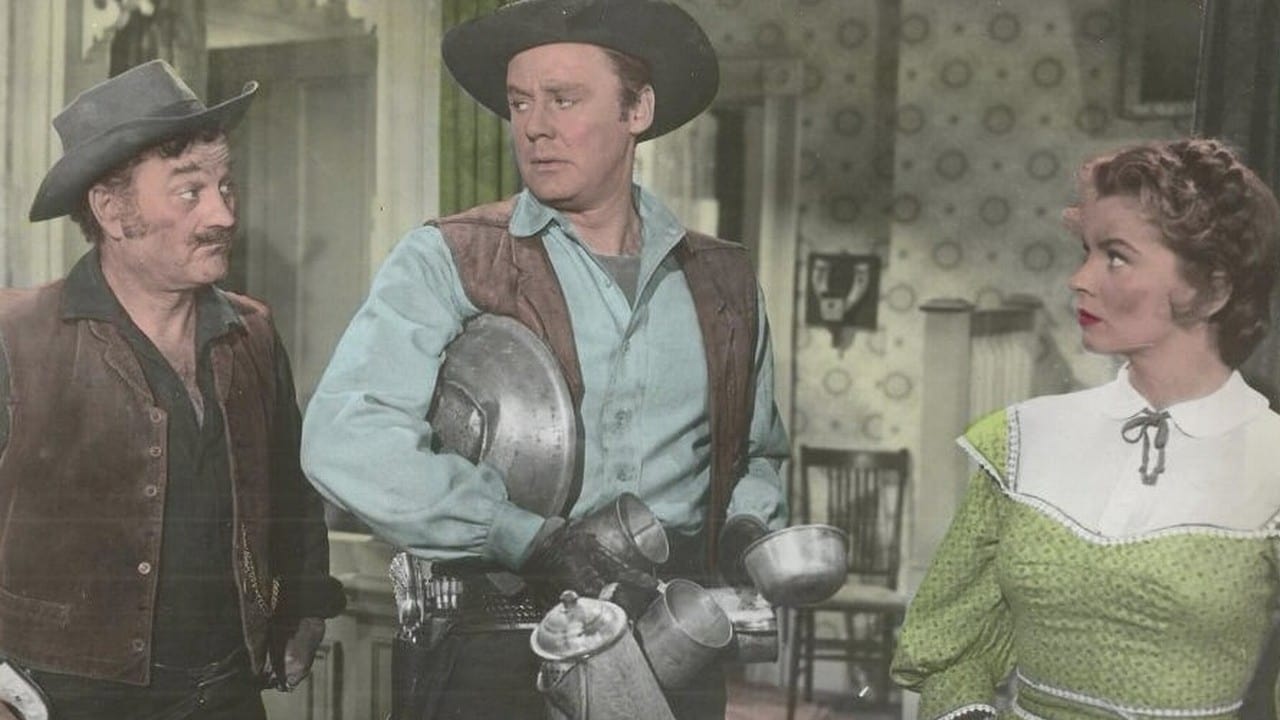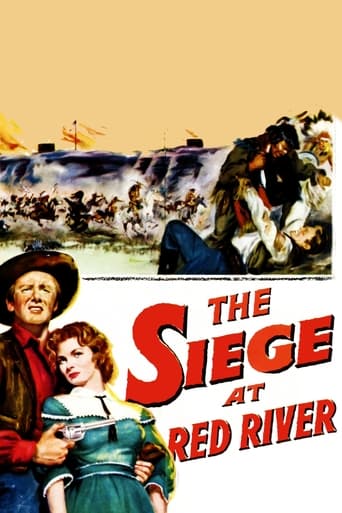

SERIOUSLY. This is what the crap Hollywood still puts out?
... View MoreReally Surprised!
... View Moren my opinion it was a great movie with some interesting elements, even though having some plot holes and the ending probably was just too messy and crammed together, but still fun to watch and not your casual movie that is similar to all other ones.
... View MoreOne of those movie experiences that is so good it makes you realize you've been grading everything else on a curve.
... View MoreTwo Confederate agents (Van Johnson and Milburn Stone) head west in order to bring a Gatling gun back to the South in the hopes of winning the Civil War. In order to travel with the famous gun through hostile Commanche territory they hire Indian trader Richard Boone to lead the way. Johnson and Stone hide their true identities by masquerading as sales reps for a cure all tonic and actually perform a song together in order to draw in a crowd. Amongst the crowds are various Confederate sympathizers who slip them concealed notes about where to go next. Also in the mix is Joanne Dru who plays a health care provider and who falls for Johnson's ruse as the tonic sales rep while gradually discovering his true Confederate identity. The action is mostly laughable, especially a big fight with Indians, though they (the Commanches) do get their hands on the Gatling gun and get a chance to use it. However, any film with Richard Boone in it is worth watching. He does not disappoint here as a sore tempered loser at poker and treacherous Indian trader. A few years later the film Rio Conchos portrayed a similar story of the Civil War out west, and this one also starred Boone. It's about ten times better than Siege At Red River.
... View MoreSiege at Red River is a good, clean, honest and highly enjoyable adventure film which happens to unfold in the old west at what appears to be somewhat of a height during the American Civil War. Throughout, there are numerous items which open up and contribute to the grubby, generally downcast nature of the film to do with shots at redemption on top of a heist sub-plot meshing in with a revenge tale neatly blending enough to make it a good crack. It's a fair old romp through some often hard material covering the pratfalls of a bunch of both male and female lowlifes cheating, stealing and charming their way through some rather inhospitable territories in aid of themselves. The film is an engaging and pleasing enough rollick, its effectiveness somewhat masked by its own simplicity and surprisingly tense overall demeanour as it rolls its leads from situation to situation with a great deal at stake looming.The film will cover that of two confederate soldiers deep into Union army, and thus enemy, territory whom pose as travelling salesmen ridding their waggon of muscle tonic and dumping such goods onto the unsuspecting locals with a catchy tune; a smirk and a wink in the process. They are charmers, operating amorally out of a front but whose presence there is much more broadly linked to that of a recently stolen, state-of-the-art Union army produced Gatling gun. Such a gun, and the catalyst of which kicks off its ambling journey around the houses, is foretold during the film's opening; a daring robbery of the train upon which this gun was being transported seeing the perpetrators initially hidden away in the mail waggon with their target granted as much secrecy as it lies hidden away from public view on account of the top Union army officials whom have denied its existence in the newspapers. The thieves, however, know about its presence and the manner in which they infiltrate the train on top of this hints at a sly professionalism very few might be able to match.It is those very salesperson's, a certain Jim Farraday played by Van Johnson and his accomplice Benjy Guderman (Stone) whom stole and are now in possession of the gun; the bedding down in a nearby town of which leads to complication that see it near impossible to get out of there without being found by the enemy whom litter the area, predominantly down to a Union army captain and his crew scouring for all of the bits and pieces which will lead them to the merchandise he's aware is around. Thank heavens, then, for the shining beacon of light that is Richard Boone's Brett Manning; a rough talking, sleazy, fist-fighting tough guy whom offers them a way out of there - then again, maybe not. Manning plays a sly and seedy customer; a womanising, gambling lout whom, it would seem, mingles around and plays guardian to a performing girl whom specialises in that of playing on-stage burlesque as he sits in the office back-stage doing what-not and probably getting a cut of her earnings to boot.The aura, or the reputation that the Gatling gun seemingly has, is highlighted by some character officials speaking of said item. The concerns raised about the gun, in that it is so advanced and so powerful, sees one official doubt that it even exists in this still feeble, pre-modern world, or if it is indeed only a rumour that such a paramount armament exists. Its presence, however, is something another man confirms is true before going on to speak of notions that it would indeed be "terrible" if it were to "fall into the wrong hands", something the film enjoys in a very basic sense of building up an off-screen MacGuffin before having the aforementioned clinical bandits make off with it – when they do, we fear the worst. Farraday and Guderman venture onwards and uncover young Nora (Dru), a nurse at a local manor house she owns whose cart is stuck in a river, Jim's somewhat displeasing attempts at getting to know her seeing him use, again, a false persona as he does with the travelling store to charm her; the bumps in the road as he transports her back seeing her invite the interaction, and despite hearing some different truths about Jim from Gunderman, she appears unperturbed and will continue on as is.The film dares us not to particularly like its leads, Farraday and Guderman; something that is indeed linked to the fact they are thieves and con-men but is more broadly linked to that of a long history of Confederate demonisation embedded within the genre of the American western. In contrast to the rather monstrous Manning, these two are fairly decent folk and it is again to the film's credit that it even attempts to go anywhere near the places it ventures toward come the finale, when ideas of redemption and men seeing the errors of their ways unfold; the film providing us with a chance to reverse prior perception and yet maintain a dramatic edge whilst weaving newfound territory naturally into the proceedings. But the film's sole joy remains observing these scuzzy lowlifes whilst in the throngs of their existence try to outsmart and manoeuvre their way out of trouble, the savage elements linked to that of the overall representation of the Native Americans uneasy in hindsight, but everything else blending well and most of it working rather expertly in the long run.
... View MoreJim Farady (Van Johnson)and his associate Benjy (Milburn Stone) appear to be hucksters ,travelling the West selling patent medicine (a muscle builder)but in reality they are spies for the Confederacy and are transporting a stolen Gatling Gun to the Confederate lines ,a journey that will take them through Indian Territory ,and the natives are not friendly. They attract the attention of a shrewd Pinkerton man Frank Kelso (Jeff Morrow)and are forced to smuggle the guns out concealed in a hospital wagon driven by the unsuspecting Nora Curtis (Joanne Dru)who is attracted ,somewhat against her will to Farady.they are betrayed by their ostensible escort ,Manning (Richard Boone)who has plans to sell the guns to the Indians for an attack on a nearby fort ,plans Farady sets out to foil.The movie is immaculately shot in Technicolor by Edward Cronjager and Rudolph Mate ensures the action moves along with vigour .The acting is good and the movie never flags ,even finding time for a unique drunk scene -the inebriate in question being Nora .The climax may appear familiar and if so this is unsurprising -the climactic battle is lifted from Buffalo Bill ,the Joel Macrae movie from an earlier decade ,and intercut with close up of the actors in this movieIts a solid action Western and enjoyable for lovers of the genre
... View MoreThis western is about two unreconstructed southerners who steal a Gatling gun from Union soldiers which winds up in the hands of an outlaw who sells the gun to Indians for gold. The film dwells on character development and takes a great deal of time detailing the two southern agents' travels from town to town delivering coded messages and trying to arrange a rendezvous with a contact to deliver the Gatling. The picture is another Blue vs. Gray conflict in the west with the Indians on the warpath against the soldiers, a plot angle that has been done better in other westerns. Van Johnson is okay as the hero and Joanne Dru is the gal who falls for Johnson. Richard Boone is a standout as a gun-running renegade in a role as a heavy he would reprise in other westerns. The supporting cast and color photography are good.
... View More